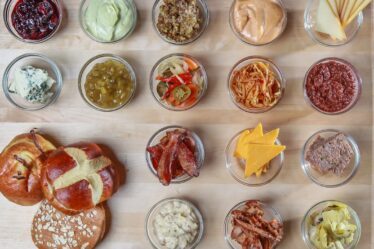
When selecting meat for hamburgers, ground beef is the most common choice, with chuck, sirloin, and round cuts being ideal due to their balanced fat-to-lean ratio. Quality ground beef should appear bright red with visible marbling. The fat content is crucial for flavor and juiciness, as leaner meat can result in drier patties.
Ground turkey or chicken are healthier alternatives to beef. When choosing ground poultry, look for packages without fillers and with adequate moisture content. These leaner meats require careful handling and cooking to prevent drying out.
Other options for hamburgers include ground pork, lamb, or meat blends. Each type of meat offers a unique flavor profile, allowing for customization based on personal preferences. Regardless of the chosen meat, using high-quality, fresh ground meat is essential for optimal results.
Key Takeaways
- Choose high-quality ground beef with a higher fat content for a juicier patty
- Form patties gently to avoid overworking the meat and creating a tough texture
- Use a simple seasoning blend of salt, pepper, and garlic powder for classic flavor
- Preheat the grill to high heat to ensure a good sear on the patties
- Cook the patties to an internal temperature of 160°F for a perfectly juicy and safe burger
Preparing the Perfect Patty
Size Matters
It’s crucial to make the patties slightly larger than the size of the bun, as they will shrink as they cook. To ensure that the patties cook evenly, make a slight indentation in the center of each patty with your thumb. This will prevent the patties from puffing up in the middle as they cook, resulting in a more uniform shape.
Seasoning and Additions
It’s also important to season the patties with salt and pepper just before grilling them, as seasoning too far in advance can draw out moisture from the meat and result in a dry patty. For those looking to add an extra level of flavor and juiciness to their burgers, consider mixing in ingredients such as minced onions, garlic, Worcestershire sauce, or even grated cheese into the meat mixture before forming the patties. These additions can take your burgers to the next level and add an extra depth of flavor.
Tips for Success
By following these simple tips, you’ll be well on your way to creating the perfect burger patty. Remember to handle the meat gently, make the patties the right size, and season them just before grilling. With a little practice and patience, you’ll be a burger master in no time!
Seasoning for Flavor

Seasoning is an essential step in creating the perfect grilled hamburger. While salt and pepper are classic choices for seasoning burgers, there are many other options for adding flavor to your patties. One popular choice is to use a pre-made seasoning blend specifically designed for burgers, which often includes a mix of spices such as garlic powder, onion powder, paprika, and cayenne pepper.
For those looking to add a smoky flavor to their burgers, consider using a barbecue rub or seasoning blend that includes ingredients such as smoked paprika or chipotle powder. This can add a delicious depth of flavor to your burgers and give them a unique twist. Another option for seasoning burgers is to use fresh herbs and aromatics such as minced garlic, chopped parsley, or grated onion.
These ingredients can add a fresh and vibrant flavor to your burgers and take them to the next level. For those looking to add an extra kick of flavor to their burgers, consider incorporating ingredients such as hot sauce, mustard, or Worcestershire sauce into the meat mixture before forming the patties. These additions can add an extra layer of complexity to your burgers and make them stand out from the crowd.
Preheating the Grill
| Preheating the Grill | Temperature | Time |
|---|---|---|
| Gas Grill | Medium-High (around 400-450°F) | 10-15 minutes |
| Charcoal Grill | Hot (ash-gray coals) | 20-30 minutes |
Before you start grilling your hamburgers, it’s important to preheat your grill properly. Preheating the grill ensures that it reaches the ideal cooking temperature and helps prevent the burgers from sticking to the grates. To preheat a gas grill, start by turning all burners to high and closing the lid.
Let the grill heat up for at least 10-15 minutes before you start cooking. This will ensure that the grates are hot enough to create those coveted grill marks on your burgers. If you’re using a charcoal grill, start by lighting your charcoal and letting it burn until it’s covered with white ash.
Once the charcoal is ready, spread it out evenly in the bottom of the grill and allow it to heat up for at least 10-15 minutes before you start cooking. It’s important to note that preheating your grill is essential for achieving a perfectly seared exterior on your burgers while keeping the inside juicy and flavorful. Skipping this step can result in uneven cooking and a less-than-ideal end result.
Cooking to the Ideal Temperature
One of the most crucial aspects of grilling hamburgers is cooking them to the ideal temperature. The USDA recommends cooking ground beef to an internal temperature of 160°F (71°C) to ensure that any harmful bacteria are killed off. This temperature will result in a well-done burger with no pink in the center.
For those who prefer their burgers with a hint of pink in the center, aim for an internal temperature of 145°F (63°C) for medium-rare or 155°F (68°C) for medium. It’s important to use a meat thermometer to accurately gauge the internal temperature of the burgers, as visual cues alone can be unreliable. When checking the temperature of your burgers, insert the thermometer into the side of each patty so that it reaches the center without touching the grill or any bones.
This will give you an accurate reading of the internal temperature and ensure that your burgers are cooked safely and to your desired level of doneness. It’s important to note that overcooking burgers can result in dry and tough meat, so it’s best to aim for an internal temperature that aligns with your preferred level of doneness while still ensuring that the meat is safe to eat.
Achieving the Perfect Grill Marks

The Secret to Visually Appealing Burgers
Grill marks are not only visually appealing but also add an extra layer of flavor and texture to your hamburgers. To achieve perfect grill marks on your burgers, start by preheating your grill as mentioned earlier.
Creating the Perfect Pattern
Once your grill is hot, place your patties on the grates at a 45-degree angle to create diagonal grill marks. After about 2-3 minutes, rotate each patty 90 degrees to create a crosshatch pattern of grill marks. This technique will give your burgers those coveted diamond-shaped grill marks that are sure to impress your guests.
Tips for Success
It’s important not to move or flip the patties too often while grilling, as this can disrupt the formation of grill marks and prevent them from developing properly. Allow each side of the patty to cook undisturbed for 3-4 minutes before flipping them over to ensure that you achieve perfect grill marks on both sides.
Charcoal Grill Tips
For those using a charcoal grill, it’s important to ensure that the coals are evenly distributed before placing your patties on the grates. This will help ensure that each patty cooks evenly and develops uniform grill marks across its surface.
Serving and Enjoying the Perfectly Grilled Hamburger
Once your hamburgers are cooked to perfection, it’s time to serve and enjoy them. Start by placing each patty on a toasted bun and adding your favorite toppings such as lettuce, tomato, onion, pickles, and cheese. Don’t forget to spread some condiments such as ketchup, mustard, mayonnaise, or barbecue sauce on the bun for an extra burst of flavor.
When serving your hamburgers, consider pairing them with classic sides such as french fries, potato salad, coleslaw, or a crisp green salad. These sides can complement the flavors of the burger and create a well-rounded meal that is sure to satisfy everyone at the table. As you take your first bite of your perfectly grilled hamburger, savor the juicy and flavorful meat along with the crispy exterior and tender interior.
The combination of smoky char from the grill marks and savory seasoning will create a mouthwatering experience that is sure to leave you craving more. Whether you’re hosting a backyard barbecue or simply craving a delicious homemade burger, following these steps will help you achieve the perfect grilled hamburger every time. From choosing high-quality meat to seasoning it just right and achieving those coveted grill marks, these tips will ensure that your hamburgers are always a hit with family and friends alike.
So fire up your grill, gather your ingredients, and get ready to enjoy the ultimate burger experience right in your own backyard.
If you’re looking for the perfect side dish to pair with your grilled hamburgers, check out this easy latke recipe guide for a delicious and crispy potato pancake option. These latkes are the perfect complement to any grilled meal and are sure to be a hit with your family and friends.
FAQs
What is the recommended internal temperature for grilled hamburgers?
The recommended internal temperature for grilled hamburgers is 160°F (71°C) to ensure they are safe to eat.
How can I check the internal temperature of grilled hamburgers?
You can use a meat thermometer to check the internal temperature of grilled hamburgers. Insert the thermometer into the thickest part of the burger to get an accurate reading.
Why is it important to cook hamburgers to the proper internal temperature?
Cooking hamburgers to the proper internal temperature is important to ensure that any harmful bacteria, such as E. coli, are killed, making the burgers safe to eat.
What can happen if I eat undercooked hamburgers?
Eating undercooked hamburgers can lead to foodborne illnesses, such as food poisoning, which can cause symptoms like nausea, vomiting, diarrhea, and stomach cramps.
How long should I grill hamburgers to reach the recommended internal temperature?
The grilling time for hamburgers can vary depending on the thickness of the patties and the heat of the grill. It is important to use a meat thermometer to check the internal temperature rather than relying solely on grilling time.



